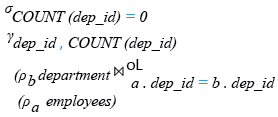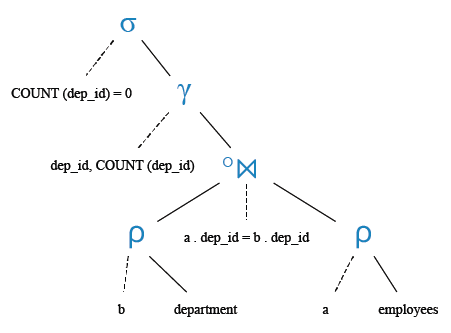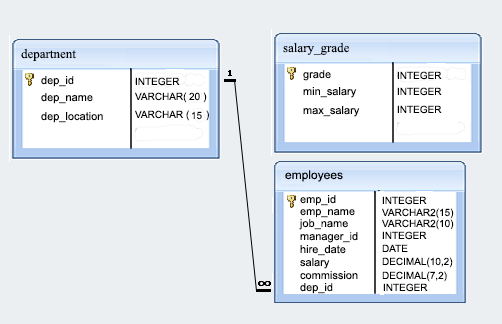SQL subqueries on employee Database: List the department where there are no employees
SQL subqueries on employee Database: Exercise-77 with Solution
[An editor is available at the bottom of the page to write and execute the scripts.]
77. From the following table, write a SQL query to find those departments where no employee works. Return department ID.
Sample table: employees
Sample table: department
Sample Solution:
SELECT b.dep_id,
count(a.dep_id)
FROM department b
LEFT OUTER JOIN employees a ON a.dep_id=b.dep_id
GROUP BY b.dep_id
HAVING count(a.dep_id) = 0;
Sample Output:
dep_id | count --------+------- 4001 | 0 (1 row)
Relational Algebra Expression:

Relational Algebra Tree:

Practice Online
Structure of employee Database:

Have another way to solve this solution? Contribute your code (and comments) through Disqus.
Previous: From the following table, write a SQL query to count the number of employees who work as a manager. Return number of employees.
Next: SQL Exercises, Practice, Solution
What is the difficulty level of this exercise?
Test your Programming skills with w3resource's quiz.
SQL: Tips of the Day
SQL Server SELECT into existing table.
INSERT INTO dbo.TABLETWO SELECT col1, col2 FROM dbo.TABLEONE WHERE col3 LIKE @search_key
This assumes there's only two columns in dbo.TABLETWO - you need to specify the columns otherwise:
INSERT INTO dbo.TABLETWO (col1, col2) SELECT col1, col2 FROM dbo.TABLEONE WHERE col3 LIKE @search_key
Database: SQL Server
Ref: https://bit.ly/3y6tpA3
- New Content published on w3resource:
- HTML-CSS Practical: Exercises, Practice, Solution
- Java Regular Expression: Exercises, Practice, Solution
- Scala Programming Exercises, Practice, Solution
- Python Itertools exercises
- Python Numpy exercises
- Python GeoPy Package exercises
- Python Pandas exercises
- Python nltk exercises
- Python BeautifulSoup exercises
- Form Template
- Composer - PHP Package Manager
- PHPUnit - PHP Testing
- Laravel - PHP Framework
- Angular - JavaScript Framework
- Vue - JavaScript Framework
- Jest - JavaScript Testing Framework
